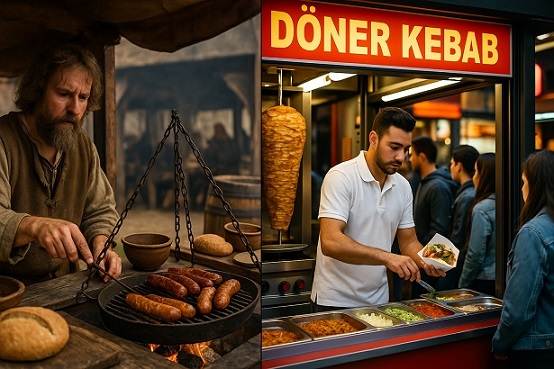
Where History Meets a Hungry Crowd
When most people think of German cuisine, they picture heavy plates served in cozy taverns. But there’s another side to Germany’s culinary culture – faster, louder, and served from a sizzling grill by the side of the road.
German street food has a rich and surprising history. It’s not just about currywurst and Döner kebab. From medieval market vendors to today’s multicultural food trucks, the street has always been one of Germany’s most flavorful stages. And as the country evolved, so did the snacks.
In this article, we trace the journey of street food in Germany – from spiced sausages sold in town squares to the Turkish-German invention that changed everything: the Döner kebab.
Medieval Markets and the Origins of German Fast Food
Street food isn’t a modern phenomenon in Germany. As early as the Middle Ages, towns and cities had bustling markets where vendors sold ready-to-eat fare to laborers, travelers, and locals who didn’t have access to their own hearths during the day.
Common medieval street foods included:
- Roasted meats: Pork and poultry were often cooked on open spits.
- Bread and cheese: Affordable, portable, and nourishing.
- Porridge or stew: Served from communal pots, these hot meals were the original fast food.
- Honey cakes and baked goods: Early precursors to Germany’s famed baking culture.
Regulated by local guilds and market laws, these food vendors laid the foundation for what would later become one of Germany’s greatest culinary strengths: high-quality, affordable, portable food.
Curious about medieval influences? Discover how The Black Forest Shaped German Mythology and Culture.
Sausages, Pretzels, and the Rise of Street Classics
As Germany’s towns grew in the Renaissance and Baroque periods, street food began to take on more recognizable forms. By the 18th and 19th centuries, several staples had already entered the street food canon:
Bratwurst
The king of German street meats, Bratwurst originated in Franconia and Thuringia, where it was sold hot off the grill in bread rolls with mustard. Today, it’s still a street food favorite.
Check out our hearty Traditional Bratwurst Recipe and Bratwurst with Sauerkraut and Potatoes recipe to bring it home.
Pretzels
Originally baked by monks, pretzels became a street vendor staple in southern Germany. Their portability, flavor, and symbolic shape made them perfect for on-the-go snacks.
Try the Brezn Recipe and bring the beer garden experience home.
Post-War Innovation: The Birth of Currywurst
After World War II, Germany faced food shortages and cultural change. In Berlin, a woman named Herta Heuwer invented a dish that would go down in street food history: Currywurst.
By mixing ketchup with curry powder (thanks to British soldiers), she created a tangy, spicy sauce to pour over chopped bratwurst. Served with fries or bread, it was cheap, hot, and filling – a working-class miracle.
Currywurst stalls soon popped up across the country, and today you’ll find entire museums dedicated to this invention. Want to try it yourself? Follow The Best Homemade Currywurst Recipe or learn more about Germany’s Love for Currywurst.
The Döner Revolution: A Turkish-German Masterpiece
No article on German street food would be complete without the Döner kebab. While its origins lie in Turkey, the Döner as we know it today was born in Berlin in the 1970s.
Turkish immigrants adapted traditional meat-on-a-spit to German tastes by:
- Serving it in a flatbread sandwich
- Adding lettuce, onions, cabbage, and sauces
- Offering chicken and vegetarian options
The result? A portable, affordable, flavor-packed meal that’s now Germany’s most popular street food, outselling even hamburgers and pizza in some cities.
Learn more about the country’s changing culinary identity in German Cuisine: Past to Present.
Modern Trends: Food Trucks, Vegan Döner, and Fusion Snacks
Today, German street food continues to evolve, embracing global influences and dietary changes. In cities like Berlin, Hamburg, and Cologne, you’ll find:
- Vegan Döner made from seitan or falafel
- Korean-German fusion, like kimchi bratwurst
- Craft pretzel sandwiches with smoked meats or cheeses
- Food trucks offering everything from schnitzel tacos to sweet Kaiserschmarrn
Yet even amid this innovation, traditional street foods remain king – especially during festivals, Christmas markets, and weekly street fairs.
Regional Specialties Worth Trying
Street food in Germany isn’t just about nationwide favorites – it’s also deeply regional:
- Thuringian Rostbratwurst: Long, thin, and spiced, often served with mustard.
- Fischbrötchen: A northern specialty – fish sandwiches with pickled herring or mackerel.
- Lángos: A Hungarian import popular in eastern markets – fried dough with garlic and cheese.
- Reibekuchen: Fried potato pancakes found at markets, best with applesauce.
If you’re hungry for more regional inspiration, explore our German Main Dishes archive.
Street Food at Germany’s Famous Markets
From Christmas stalls to Oktoberfest stands, Germany’s markets are street food havens:
- Oktoberfest in Munich: Pretzels, sausages, roast chicken, and more. Learn the rituals behind the revelry in our deep dive into Oktoberfest Traditions.
- Weihnachtsmärkte: Bratwurst, candied almonds, and steaming mugs of Glühwein.
- Fasching (Carnival season): Deep-fried sweets and savory snacks abound – see how Germans celebrate with flair in Fasching: The German Carnival.
More Than a Meal on the Go
Street food in Germany is more than just a quick bite – it’s a reflection of history, migration, ingenuity, and regional pride. From monks baking pretzels to immigrants revolutionizing fast food, German street cuisine has never stopped evolving.
So next time you unwrap a currywurst or bite into a late-night Döner, remember: you’re not just eating a snack – you’re tasting centuries of culture in one delicious bite.
